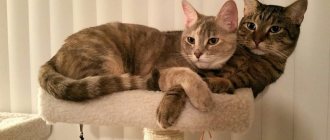Many cat owners are sure that their pets can also get the flu. Along with news about bird or swine flu, information about dog or cat flu periodically appears in the press. But in fact, there is no such disease as cat flu, says Natalya Solovyova, chief physician of the veterinary clinic. Rhinotracheitis causes symptoms similar to human influenza in cats. This is what is often called cat flu, the symptoms and treatment of which raise many questions among animal owners.
Do cats get colds?
Cats, like all mammals, are susceptible to colds. Their symptoms are similar to those of humans. Cats have very strong immunity, and they successfully cope with most viruses and germs without drug intervention. However, other viral diseases of cats - rhinotracheitis, calicivirus - can also be hidden under the symptoms of a cold.
It is important to monitor your pet’s condition and promptly contact a veterinarian if alarming symptoms are detected:
- weakness - the cat gets tired quickly, does not play and sleeps more than usual;
- a dry nose is a sign of fever;
- hot ears are another symptom of hyperthermia;
- runny nose - pathogenic microorganisms are removed from the body with liquid secretions;
- lacrimation;
- Coughing and sneezing are a natural reflex to clear the lungs of accumulated mucus, but when a kitten is constantly coughing, it is alarming.
These symptoms may be a sign of more serious respiratory diseases, infectious or viral diseases, or allergies. Therefore, the cat must be shown to the veterinarian if such symptoms occur.
What complications can a cold cause?
A cold in a cat, especially a kitten, can lead to disruption of the functioning of internal organs. If left untreated, the viral infection affects the bronchi, lungs, joints and kidneys. The animal’s immunity decreases, and inflammatory processes caused by bacteria occur:
- pneumonia (the disease is accompanied by damage to the lung tissue, often leading to the death of the animal);
- bronchitis (characterized by inflammation of the mucous membranes of the bronchi, the appearance of a cough with the discharge of thick sputum and breathing problems);
- bacterial arthritis (accompanied by pain and decreased joint mobility);
- pyelonephritis and cystitis (inflammatory processes in the kidneys and bladder lead to disruption of urine production processes and poisoning of the body with metabolic products).
Can a cat catch a cold from a person?
Not all owners know whether cats can become infected from them. The symptoms of cat and human colds are similar, but the pathogens are different.
Important! A person cannot become a source of infection for a pet, because the pathogens of ARVI and regular flu are not dangerous for cats. Even if the whole family is sick with the virus, your pet is safe. But if the cause of the disease is caused by a bacterial infection, then the cat may also get sick.
Most colds and flus cannot cross the species barrier. But the influenza A strain is insidious and dangerous. It is capable of mutating and being transmitted from one species of mammal to another. Now different atypical strains are appearing: the so-called swine, avian, and coronavirus.
They can pass from person to animal and back. In addition, there is no cure for such diseases, because scientists do not have time to create an effective vaccine that would be able to resist the mutating virus. Treatment is symptomatic.
Interesting! In 2009, the cat died from the H1N1 flu, the so-called swine flu, which it most likely contracted from its owner. COVID-19 can also be transmitted to cats, which has already been recorded in Belgium. As a result of such infections, the disease in animals progresses rapidly and they do not survive. But cats cannot be carriers of this insidious infection.
During quarantine, you need to observe basic hygiene standards: do not throw away used handkerchiefs, avoid close contact with your pet.
Treatment and prevention
Vaccination and regular booster vaccinations will keep your cat healthy and help prevent disease. Another key factor is protecting yourself from germs: wash your hands thoroughly and often (and ask others to do the same); Disinfect any contaminated areas such as bedding, clothing and towels; and avoid contact with any person (and any animal) who may be sick.
Animals can contract diseases from other animals, so it is important to keep your healthy cat away from sick animals. Eye and ear discharge and saliva are the most common ways animals spread germs, so feed and water them in different places.
As noted, if you suspect the flu or cold, contact your veterinarian immediately. According to PetMD, “There is no cure for influenza and treatment is symptomatic. Regular care may be required to clear discharge from the eyes and nose and keep them clean.” Possible treatments include antibiotics and plenty of fluids to prevent dehydration. Your veterinarian will give you a detailed treatment plan.
Your cat will need a lot of love and care during her recovery, and she will happily do the same for you if you ever get sick. It may not be easy if you are sick too, but once you are both healthy, you will happily embrace each other.
What to do if your cat has a cold
If your cat exhibits cold symptoms: runny nose and cough, watery eyes, dry nose, and is lethargic and does not eat well, it is recommended to go to the veterinary clinic. Laboratory tests may be needed to make an accurate diagnosis.
Important! In the case of animals, you cannot self-medicate, because human medications and human dosages are not suitable for them.
Timely comprehensive vaccinations can protect the animal from a number of viral diseases. And for bacterial infections, antibiotics are prescribed, which must be taken on schedule. For any illness, infected cats are prescribed complex therapy, which includes symptomatic treatment and restorative medications that help the animal overcome the disease faster.
Colds are dangerous for cats because if help is not provided in time, it can cause the death of the animal.
During treatment, you must follow the general rules:
- Do not allow the animal to become dehydrated, so the water bowl should be constantly filled.
- When sick, kittens may experience discharge from the nose and eyes. It is necessary to wash your pet regularly and carefully wipe away any secretions with a damp cloth.
- A sick cat usually has a poor appetite, but he needs to eat to maintain vitality. Familiar food can be slightly warmed up to make it smell stronger and arouse your pet's interest. You can also offer a sick cat something tasty and new. To make the food easier to eat and swallow, it can be diluted with water.
Cat colds are not dangerous for the owner, so the question of whether you can get a cold or flu from a cat should not arise. However, they can cause infection to other pets if they live in the same room. A sick animal needs to be isolated; a week is usually enough to treat a cold.
How is the disease treated and prevented?
According to Solovyova, proper vaccination protects against rhinotracheitis by 99%. “Vaccination is carried out for cats in childhood twice with an interval of 3-4 weeks, then it is done strictly once a year. If it is missed several times and there is a gap of 2-3 years, you have to do a second two-time vaccination,” explains the expert.
If your cat has not been vaccinated and becomes ill, you should contact your veterinarian. “Since this is a viral disease, treatment begins with the administration of antiviral globulins and serums. In parallel, antibiotics can be used as additional therapy, since viral diseases are always accompanied by activation of microflora. An antibiotic, as is known, does not act on viruses, but fights bacteria that aggravate the course of a viral disease. Additionally, sick cats should be given vitamins; sometimes they are added to immune preparations,” says Solovyeva.
The condition called flu in cats requires complex therapy. It cannot be ignored, as complications may arise.
Treatment at home: what medications can be given?
There are no special medications to treat colds in cats. Veterinarians recommend treating the disease with drugs that boost immunity and relieve symptoms. During therapy, the pet needs to be provided with comfortable living conditions, proper nutrition and rest.
Antibiotics
Colds in cats are treated with antibiotics when bacterial infections occur. Drugs must be selected with caution. Not only the recovery, but also the life of the pet depends on this. The most commonly prescribed medications for cats are:
- oxytetracycline;
- gentamicin;
- amoxicillin;
- chloramphenicol;
- kanamycin.
It is important to correctly calculate the dose of the drug, which depends on the weight, age and general condition of the cat’s body. For colds in cats, treatment at home involves following the administration regimen drawn up by the doctor. Otherwise, the drug is ineffective. The course of antibacterial therapy lasts 7-10 days. You should not interrupt treatment, even if the symptoms disappear after 3-4 days. If you refuse further administration of antibiotics, the infection may become chronic.
Injections
Both antibiotics and immunostimulating agents are injected. The administration of vitamins has a positive effect on the cat's condition. If the cold is severe, the animal can be treated with interferon. The product has a high price and has a number of side effects. It can be replaced with immunoglobulins - antibodies obtained from a recovered animal. They act only in the first days of illness. It is recommended to give injections to your cat at a veterinary clinic.
Nasal rinsing
The procedure helps clear the nasal passages of mucus secretions and restore breathing. For this purpose the following drugs are used:
- 2% zinc sulfate solution;
- 3% boric acid;
- 0.5% tannin solution;
- a mixture of adrenaline and novocaine.
A small amount of liquid is drawn into a pipette or syringe without a needle. The animal is placed on its side, holding its head. The medicine is injected into the nasal passage and the animal is allowed to lie down. After washing, you can drip a mixture of 1% methanol and fish oil. This remedy softens the mucous membranes, eliminating signs of irritation and inflammation.
Use of human medicines
In treating a cat, you can use some of the remedies used to treat colds in humans. Derinat and Nazivin drops help to cope with a runny nose. The recommended single dose for an adult cat is 1 drop. The use of some medications from a human medicine cabinet can be fatal to a pet. Antipyretics based on paracetamol and aspirin are toxic to cats. In addition, due to the small weight of the animal, it can be difficult to calculate and obtain the required dose of the drug.
Symptoms of the disease
Cats have a unique physiology, so when they have a cold, they may have a hot, dry nose, poor appetite, drowsiness, fearfulness and apathy. However, the symptoms listed are also typical for other cat ailments. Among them is infectious pneumonia in cats, the symptoms and treatment of which differ in some ways from the symptoms and treatment of the common cold. To accurately diagnose a cold, it is worth paying attention to other warning signs that are a signal for owners and indicate the need to visit a veterinary clinic.
Typical clinical symptoms of a cold in cats are presented as follows:
- greenish discharge from the sinuses;
- weakness, fatigue;
- difficulty breathing through the nose;
- irritation of mucous membranes;
- sneezing and coughing;
- tearfulness of the eyes.
If the owner suspects that the pet has a cold and has the symptoms listed above - lethargy, watery eyes, coughing in cats, the symptoms and treatment of the disease must be confirmed by a veterinarian.











